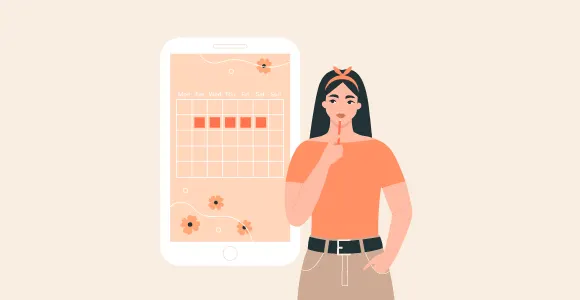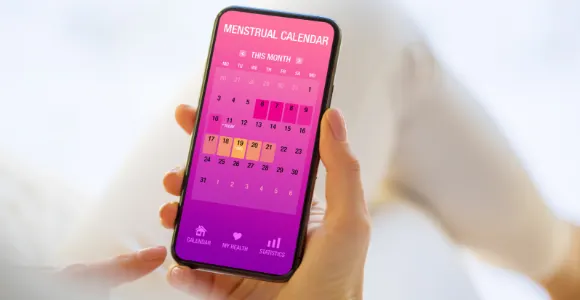How to Use Ovulation Calendar to Track Your Fertile Days

You can use an ovulation calendar to know your fertile window by keeping a track of your menstrual cycle.
If you're trying to conceive, identifying your ovulation day is key to increasing your chances of pregnancy. An ovulation calendar is a helpful tool that tracks your menstrual cycle to pinpoint your fertile window — the days you're most likely to conceive. By monitoring your cycle, an ovulation calendar or calculator predicts when you're ovulating and helps you plan accordingly.
Some advanced calendars also take into account details like your basal body temperature and cervical mucus consistency for improved accuracy. For instance, your basal body temperature — recorded first thing in the morning before any activity — often rises slightly during ovulation. Understanding and charting these subtle changes gives you deeper insight into your cycle and helps you accurately determine your ovulation day.
For example, basal body temperature is a measure that is recorded when you're completely at rest, preferably when you've just woken up in the morning. This information has a direct correlation with your menses, thus making it an important factor.
If you're confused about how or where to begin, here's a quick primer.
How Does an Ovulation Calendar Work?
An ovulation calendar works by helping you track your menstrual cycle to estimate your ovulation day and identify your most fertile window. To begin, you’ll typically need to enter the average length of your cycle and the first day of your last period. Using this data, the calendar calculates the luteal phase—the time between ovulation and the start of your next period.
If you're unsure of your luteal phase length, tracking your basal body temperature can offer greater accuracy. A slight rise in temperature usually indicates ovulation has occurred. You can also monitor changes in cervical mucus, which becomes clearer and stretchier during your fertile days.
Based on all the information you provide—cycle length, ovulation symptoms, and more—the ovulation calculator will predict the days you’re most likely to conceive. For many women, these are the few days leading up to and including their ovulation day. By simply entering your menstrual data into a reliable ovulation calendar, you can gain valuable insights into your fertility cycle and optimise your chances of conception.

The luteal period is the best time to conceive and usually signals the most fertile period in women.
How Accurate Are Ovulation Calendars?
While ovulation calendars are a helpful tool for estimating your ovulation day and fertile window, it’s important to understand that they offer approximations, not guarantees. Even with accurate input—like your cycle length and start date—your body’s natural rhythms can vary from month to month.
That said, these calendars still provide a solid foundation for planning. Rather than focusing on a single ovulation day, it's best to consider a range of fertile days. Since sperm can survive in the reproductive tract for up to five to seven days, having regular intercourse in the days leading up to and shortly after your predicted ovulation increases your chances of conception.
In short, while ovulation calendars aren’t 100% precise, they are a valuable guide when trying to conceive—especially when combined with other fertility tracking methods like basal body temperature and cervical mucus monitoring.

Spot Your Ovulation Signs
In order to efficiently use an ovulation calendar, here are some signs that you must observe in your body to confirm ovulating days.
- The consistency of your cervical mucous discharge from the time your period ends to the next cycle. Chart it for a couple of months to get a fair idea and an average span
- Recording your basal body temperature is another more precise way to gauge when you will be ovulating since your body temperature will spike by about half a degree when you're ovulating.

Other Methods to Predict Ovulation
If using an ovulation calendar feels overwhelming or time-sensitive, consider alternative methods like ovulation predictor kits (OPKs). These kits detect the surge in luteinising hormone (LH) that typically occurs 24 to 36 hours before your ovulation day, offering a more immediate and accurate reading. They're easy to use, affordable, and available at most pharmacies. You can also track ovulation through signs like changes in basal body temperature or cervical mucus. Whichever method you choose, consistency is key. Over time, you’ll begin to notice patterns and gain better insight into your cycle and fertile window.

Where Do You Get an Ovulation Calendar or Calculator?
There is a host of apps on the Internet to chart your menses and gauge your fertile window. You can choose one based on your preference. You can use Always’ Ovulation Date Calculator tool which provides a comprehensive understanding of your cycle, including your fertile window, ovulation days and provides insights into the best times for conception. To use it, you have to simply answer three questions about your menstrual cycle and click ‘Track it’.

Disclaimer
Please note the date of last review or update on all articles. No content on this site, regardless of date, should ever be used as a substitute for direct medical advice, diagnosis or treatment from your doctor or other qualified clinician. Always is committed to ensuring that all of our products meet rigorous safety standards; Always pads prioritize safety, protection and comfort of its consumers.











